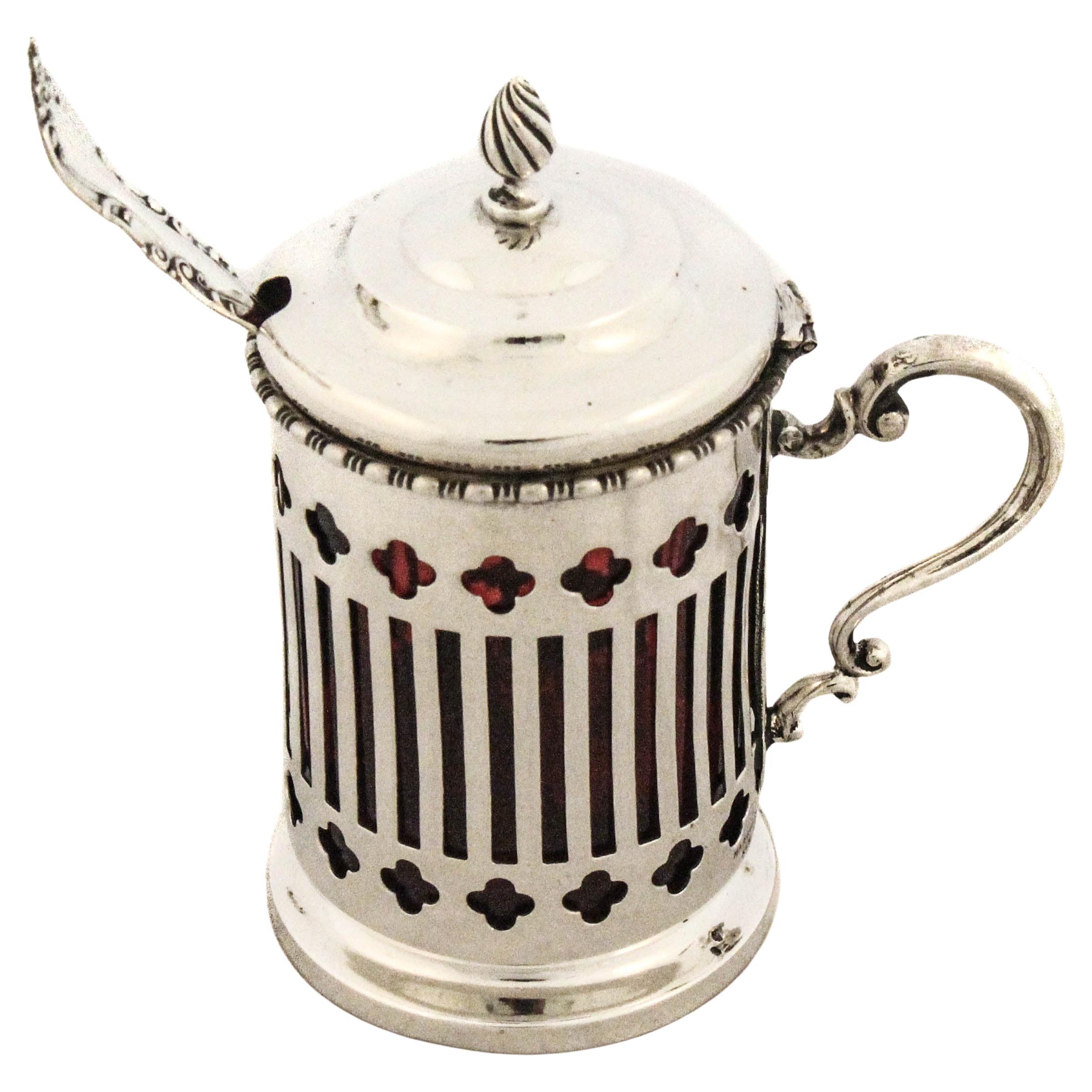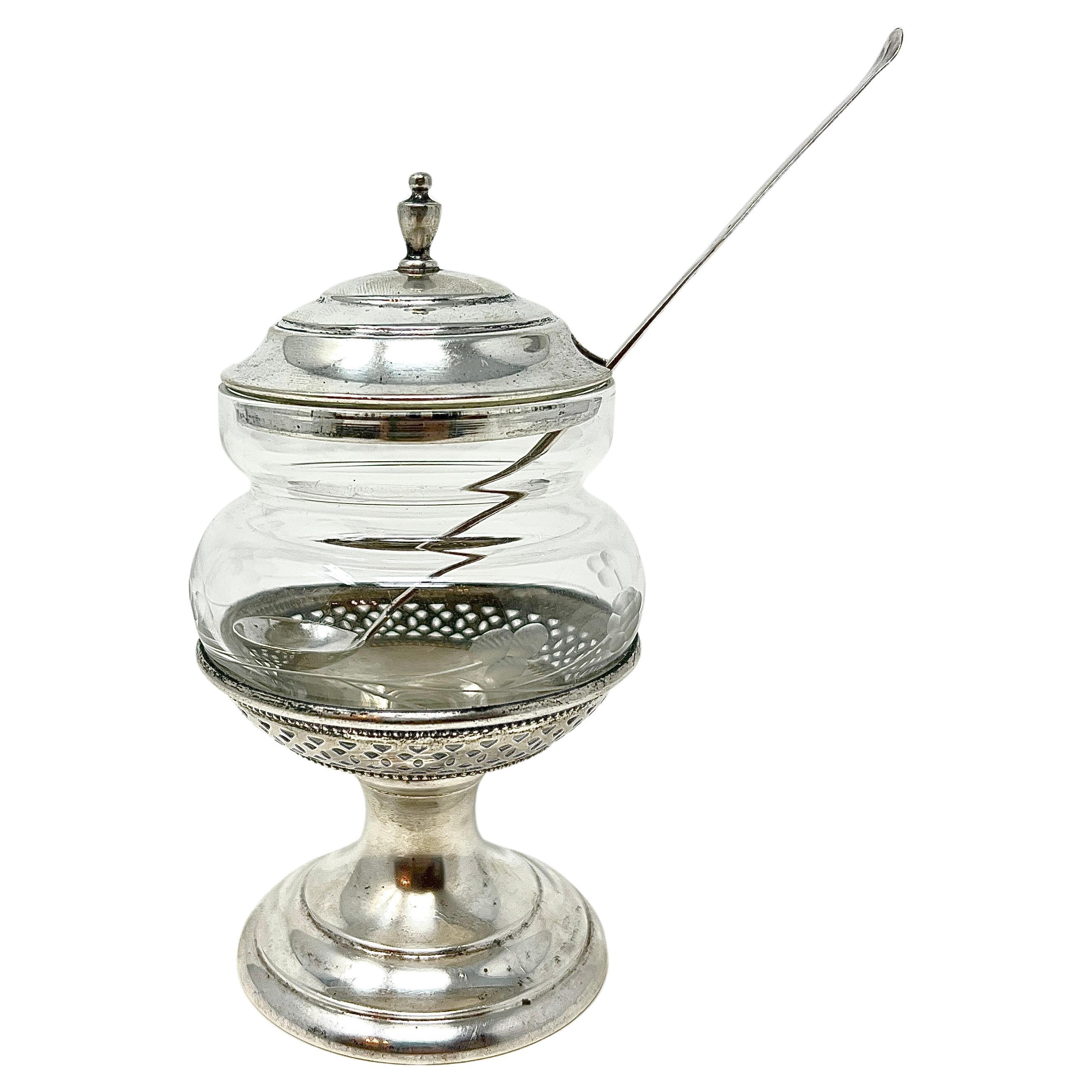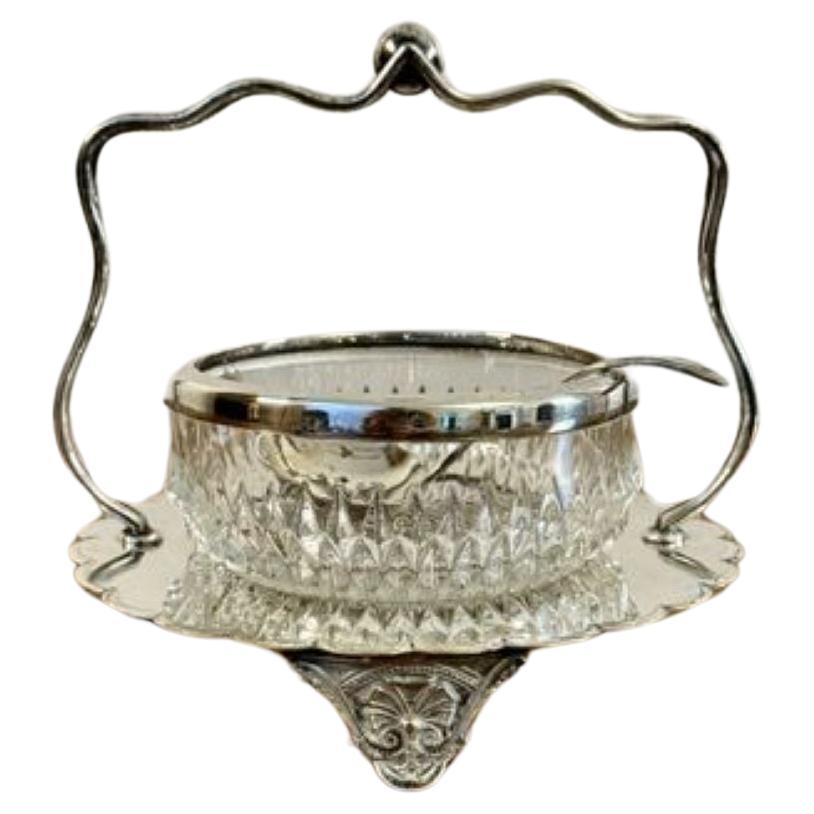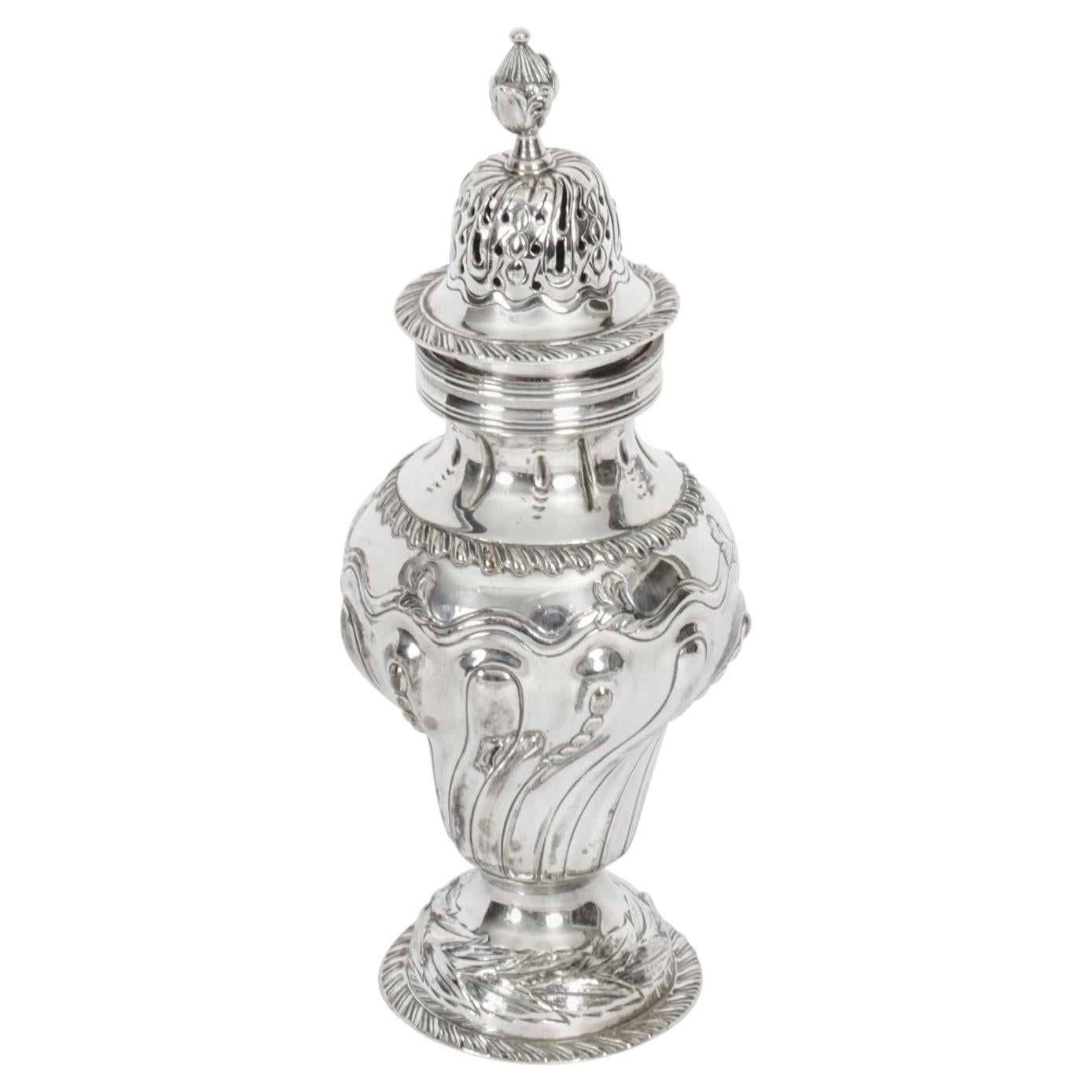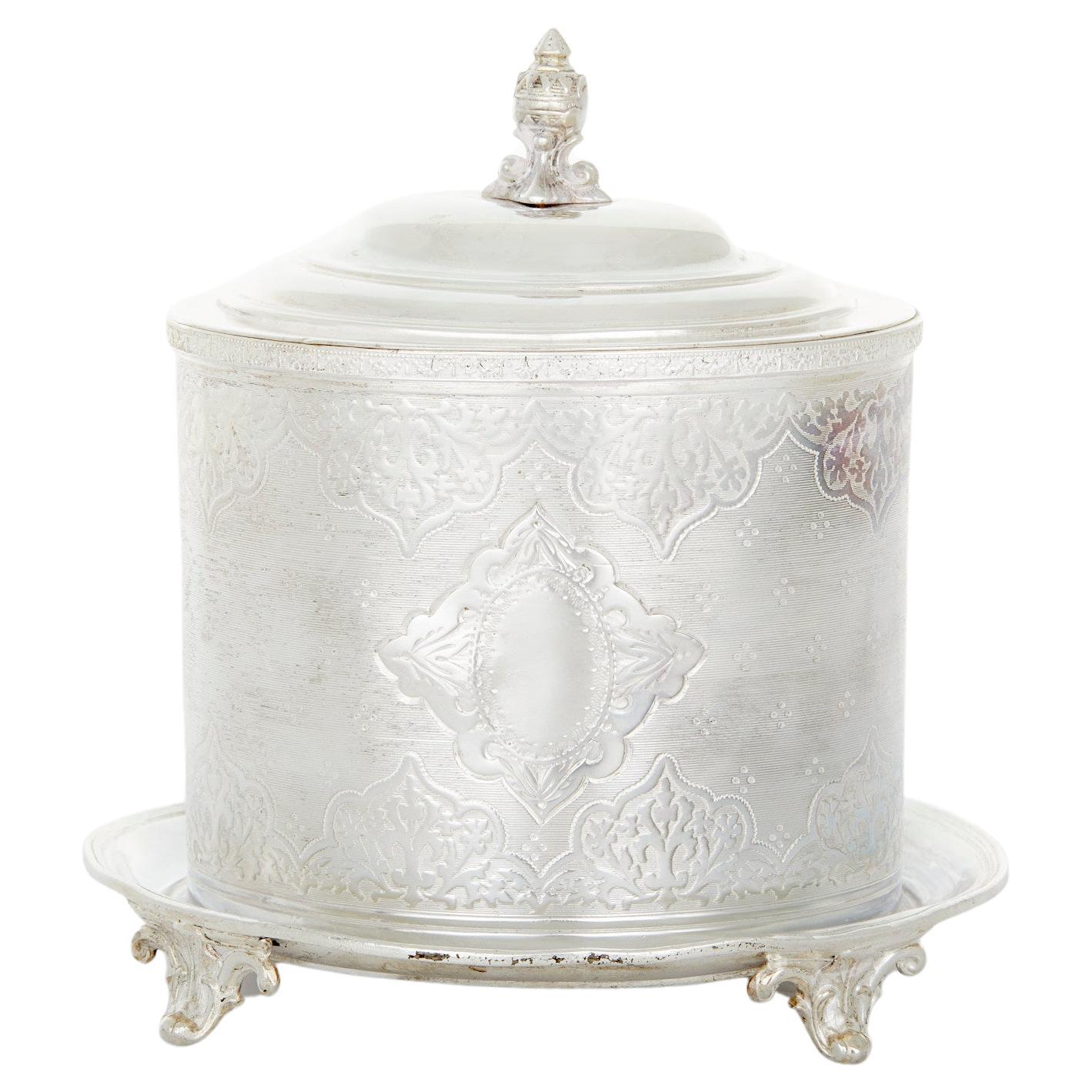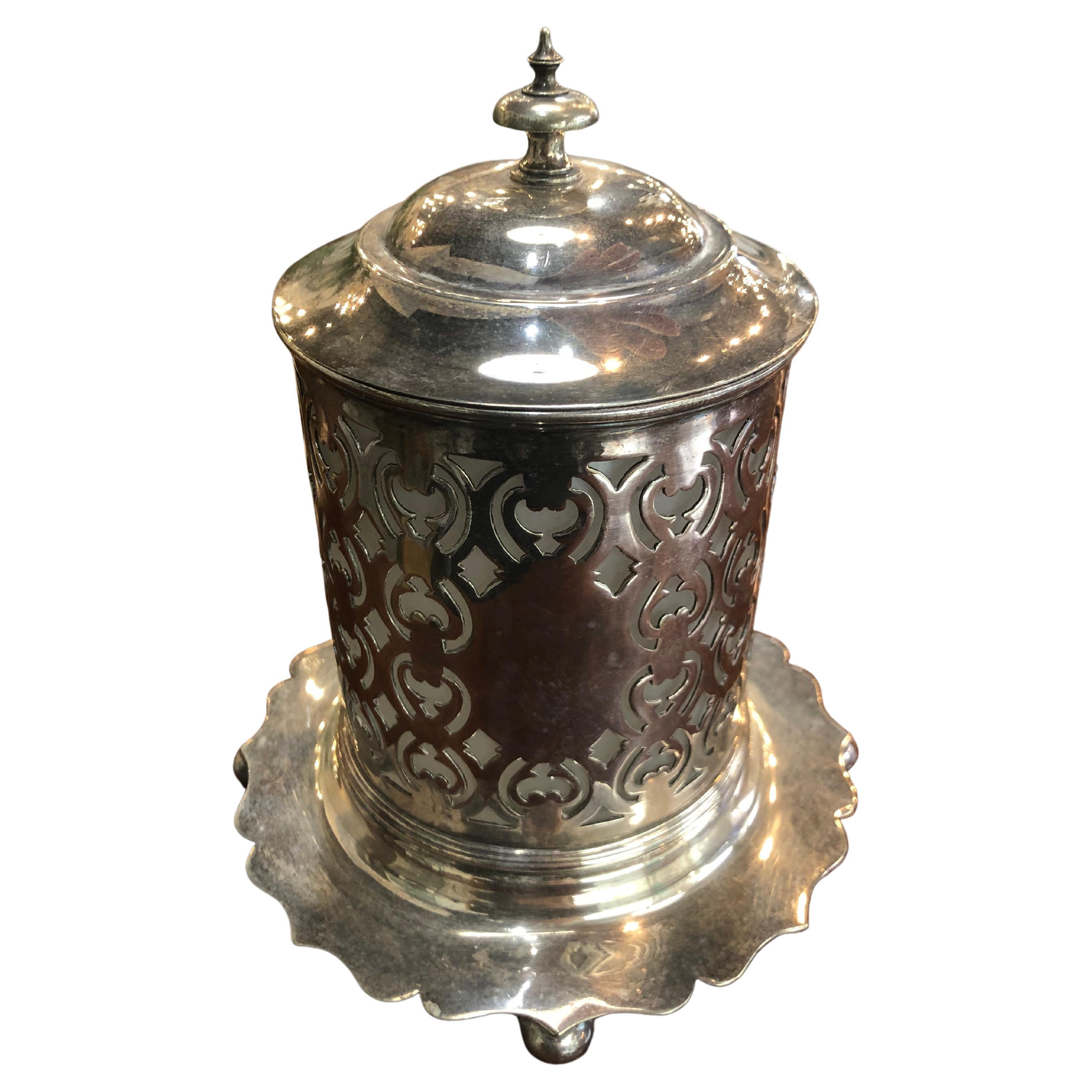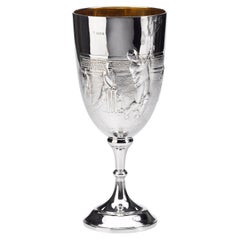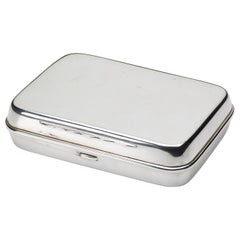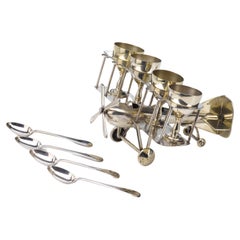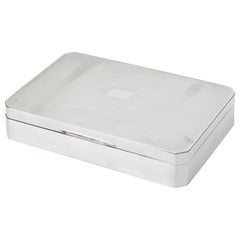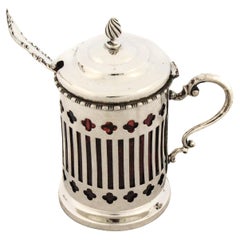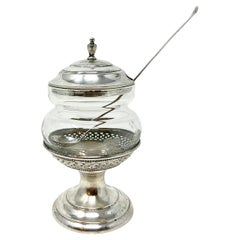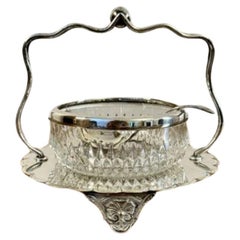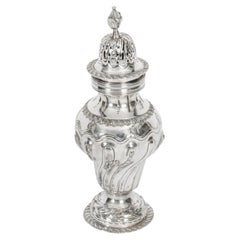Items Similar to Silver Sheffield Cricket Sugar Jar, circa 1900
Want more images or videos?
Request additional images or videos from the seller
1 of 5
Silver Sheffield Cricket Sugar Jar, circa 1900
$1,950
£1,478.37
€1,704.17
CA$2,746.26
A$3,045.40
CHF 1,600.13
MX$37,209.63
NOK 20,019.84
SEK 18,792.04
DKK 12,721.94
About the Item
This is an exquisite early 20th century crystal jar with a silver lid and spoon. The lid's top is fashioned after a cricket wicket. The jar sits on a round silver base with decorative crossed cricket bats. There is a silver braided band that encircles the etched crystal jar. The base has three spherical feet.
This is a timeless piece that can be displayed at home or put to use on the dining table. The silver hallmark is visible on the bottom of the base.
The sport of cricket has a known history beginning in the late 16th century. Cricket originated in south-east England. Cricket was prominent in London as early as 1707 and, in the middle years of the century, large crowds flocked to matches on the Artillery Ground in Finsbury. It became the country's national sport in the 18th century. The single wicket form of the sport attracted huge crowds and wagers to match, its popularity continuing throughout the 19th and 20th centuries. It has since developed a global following.
CONDITION:
Good condition. Hallmarked silver at base. Stamped "8847" along with five hallmarks. The jar measures 5" tall and 5" wide at widest point. Spoon measures 6" long.
- Dimensions:Height: 5 in (12.7 cm)Width: 5 in (12.7 cm)Depth: 5 in (12.7 cm)
- Materials and Techniques:
- Place of Origin:
- Period:
- Date of Manufacture:1900-1930
- Condition:Wear consistent with age and use. Overall very good condition. Silver hallmark at bottom.
- Seller Location:Colorado Springs, CO
- Reference Number:Seller: S0081stDibs: LU90973200952
About the Seller
4.9
Vetted Professional Seller
Every seller passes strict standards for authenticity and reliability
Established in 2010
1stDibs seller since 2011
464 sales on 1stDibs
- ShippingRetrieving quote...Shipping from: Colorado Springs, CO
- Return Policy
Authenticity Guarantee
In the unlikely event there’s an issue with an item’s authenticity, contact us within 1 year for a full refund. DetailsMoney-Back Guarantee
If your item is not as described, is damaged in transit, or does not arrive, contact us within 7 days for a full refund. Details24-Hour Cancellation
You have a 24-hour grace period in which to reconsider your purchase, with no questions asked.Vetted Professional Sellers
Our world-class sellers must adhere to strict standards for service and quality, maintaining the integrity of our listings.Price-Match Guarantee
If you find that a seller listed the same item for a lower price elsewhere, we’ll match it.Trusted Global Delivery
Our best-in-class carrier network provides specialized shipping options worldwide, including custom delivery.More From This Seller
View AllSterling Silver Cricket Trophy, circa 1923
Located in Colorado Springs, CO
This is a handsome sterling silver trophy dating to circa 1923. Detailed in raised relief on the the goblet-shaped trophy is an energetic cricket scene. It shows a cricket batter as ...
Category
Vintage 1920s British Sports Equipment and Memorabilia
Materials
Sterling Silver
Hallmarked Silver Plated Keepsake Box, Sheffield, Uk, Circa 1900
Located in Colorado Springs, CO
Offered is a stunning Sheffield silver keepsake box dating to 1900, with associated hallmark. This small box includes a clean interior and rounded corners. The box is free of names or initials, but would have been used to house keepsakes such as jewelry or cufflinks. A well maintained, elegant piece, this antique silver box is an excellent addition to any silver collection.
Trinket or keepsake boxes have taken on many forms since their first conception in ancient times. However their purpose remains the same; to store jewelry and other items precious to the owner. Originally, these boxes were used specifically for jewelry. These were in common use as early as 5000 BC in Ancient Egypt, when the majority of Egyptians, both male and female, wore jewelry. Boxes were used to keep these gemstone encrusted items safe. In Ancient Rome, jewelry was a status symbol. Rings and brooches were utilized to represent ones status in society. Again, boxes were needed for security and storage purposes. Finding early examples of these are quite rare.
Victorian and Edwardian examples of trinket boxes are far more common. This is because owning jewellery was a luxury until the Victorian era- let alone possessing so much a box was needed to store it all. Fine jewelry and other items became available to the masses after the industrial revolution due to the reduction in production costs. This led to a demand for trinket boxes, which were much smaller than jewelry boxes and therefore better suited to the needs of the middle class who did not yet possess an abundance of jewelry.
In Victorian households, collectables and other items of interested were also stashed inside these boxes. This is why they are known as trinket or keepsake boxes, rather than just jewelry boxes, although of course jewelry was also stored in them. Trinket boxes were produced in large numbers around this time. Many were lined with colored plush or velvet or rich wood. More elaborate designs had interior divisions and trays for rings and other pieces of jewellery. It was also common to see trinket boxes so small that they could only contain one item, such as a single ring. Ornate exteriors were created to reflect the value of the trinket boxes contents.
The Edwardian era saw the introduction of new styles of trinket box. These included small circular or oblong boxes...
Category
Antique Early 1900s British Art Deco Decorative Boxes
Materials
Silver
Silver Plated Airplane-Themed Tableware, circa 1910
Located in Colorado Springs, CO
This is a beautiful silver-plated egg cup and spoon set with an airplane motif, dating to the early 1910s. The set includes four matching footed egg cups. The cups sit upon the stack...
Category
Vintage 1910s English Art Deco Sheffield and Silverplate
Materials
Silver
Hallmarked Silver Plated Keepsake Box, Sheffield, UK, circa 1900
Located in Colorado Springs, CO
Offered is a stunning silver plated keepsake box dating to 1900, with associated hallmark. This small box includes a wooden interior with two slots and a blank square on top where initials could have been engraved. A well maintained, elegant piece, this antique silver box is an excellent addition to any silver or home decor collection.
Trinket or keepsake boxes have taken on many forms since their first conception in ancient times. However their purpose remains the same; to store jewelry and other items precious to the owner. Originally, these boxes were used specifically for jewelry. These were in common use as early as 5000 BC in Ancient Egypt, when the majority of Egyptians, both male and female, wore jewelry. Boxes were used to keep these gemstone encrusted items safe. In Ancient Rome, jewelry was a status symbol. Rings and brooches were utilized to represent ones status in society. Again, boxes were needed for security and storage purposes. Finding early examples of these are quite rare.
Victorian and Edwardian examples of trinket boxes are far more common. This is because owning jewellery was a luxury until the Victorian era- let alone possessing so much a box was needed to store it all. Fine jewelry and other items became available to the masses after the industrial revolution due to the reduction in production costs. This led to a demand for trinket boxes, which were much smaller than jewelry boxes and therefore better suited to the needs of the middle class who did not yet possess an abundance of jewelry.
In Victorian households, collectables and other items of interested were also stashed inside these boxes. This is why they are known as trinket or keepsake boxes, rather than just jewelry boxes, although of course jewelry was also stored in them. Trinket boxes were produced in large numbers around this time. Many were lined with colored plush or velvet or rich wood. More elaborate designs had interior divisions and trays for rings and other pieces of jewellery. It was also common to see trinket boxes so small that they could only contain one item, such as a single ring. Ornate exteriors were created to reflect the value of the trinket boxes contents.
The Edwardian era saw the introduction of new styles of trinket box. These included small circular or oblong boxes...
Category
Antique Early 1900s English Art Deco Decorative Boxes
Materials
Silver
$600 Sale Price
20% Off
Silver Plated Keepsake Box, Early 20th Century
Located in Colorado Springs, CO
Offered is a silver plated keepsake box, dating to the early 1900s. The hallmarked box offers great storage solution for jewelry, cufflinks, and other keepsakes, with a divided inter...
Category
Antique Early 1900s English Jewelry Boxes
Materials
Silver
1911 Tiffany & Co. Diamond-Encrusted Sterling Silver Polo Trophy
By Tiffany & Co.
Located in Colorado Springs, CO
This magnificent sterling silver polo trophy was crafted by the estimable Tiffany & Co in 1911. The Adam's style urn body and top is brilliantly crafted in the classical vein, with simple braided trim, two elegant long handles, and a neoclassical finial on the top. At center is the show-stopping and impressively sized silver polo player...
Category
Vintage 1910s English Adam Style Sterling Silver
Materials
Multi-gemstone, Sterling Silver
You May Also Like
Sterling Silver Mustard Jar w/ Spoon
By Marcus & Co.
Located in Brooklyn, NY
A refined sterling silver mustard jar and matching ladle crafted by Marcus & Company of New York, a distinguished American jeweler and silversmith active during the late 19th and ear...
Category
Vintage 1920s American Sterling Silver
Materials
Sterling Silver
Antique American Sterling Silver & Crystal Mustard Pot w/ Spoon, Circa 1890-1900
Located in New Orleans, LA
Antique American Sterling Silver & Crystal Mustard Pot with Spoon, Circa 1890-1900.
Category
Antique Late 19th Century American Tableware
Materials
Crystal, Sterling Silver
Elegant antique Edwardian silver plated jam pot and spoon
Located in Ipswich, GB
Elegant antique Edwardian silver plated jam pot and spoon, having an elegant cut glass jam pot with a silver plated rim standing on a silver plated stand with a shaped handle to the ...
Category
Early 20th Century English Edwardian Sheffield and Silverplate
Materials
Silver Plate
Antique Victorian Silver Plated Sugar Caster William Batt & Sons 1860, 19th C
Located in London, GB
A large beautiful Victorian silver plated sugar caster made by William Batt & Sons Ltd, circa 1860 in date.
It features typical baluster form and is embossed with lavish decorati...
Category
Antique 1860s English Victorian Sheffield and Silverplate
Materials
Silver Plate
English Sheffield Silver Plate Tea Caddy
Located in Tarry Town, NY
English sheffield silver plate covered biscuit box / tea caddy with exterior design details and finial top cover . The tea caddy / box is in goo...
Category
Antique 1860s English Sheffield and Silverplate
Materials
Silver Plate, Copper
$1,352 Sale Price
20% Off
England, 1880, Pierced Silver Plated Jam Pot with a Frosted Liner and Bun Feet
Located in Stamford, CT
Late 19 century pierced silver plated jam pot with a frosted liner and bun feet circa 1880 England. This is a wonderful piece from a private collector but I do not believe the froste...
Category
Antique Late 19th Century English Sheffield and Silverplate
Materials
Silver Plate
More Ways To Browse
Jars With Silver Lids
Large Glass Jars
18th Century Silver Spoon
Large Antique Glass Jar
Cricket Tables
Crystal Spoon
Antique Silver Topped Jars
Sugar Jar
Antique Cricket Table
Cricket Table Antique Furniture
Crystal Jar Lid
Crystal Jar With Silver
19th Century Cricket Table
Dining Tables 6 Feet Long
18th Century Cricket Table
16th Century Spoon
Antique Sheffield Cutlery
Sheffield Plate Coaster
